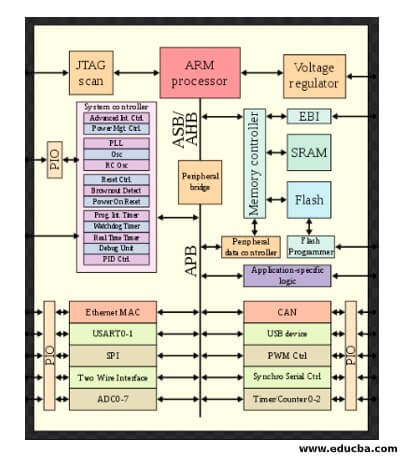Updated April 11, 2023
Introduction to ARM Architecture
Advanced RISC Machine or Acorn RISC Machine is the architecture with different computing architectures set to be used in different environments. 32-bit and 64-bit can be used here in different computer processors. It was developed by Arm Holdings and the architecture is updated in between. This architecture is specified to be used with CPU, different chips in the system, and in different registers. Reduced Instruction Set Computing helps in creating instructions for the system to be used for several purposes. Smartphones, microcomputers, and embedded devices also use ARM architecture for the instruction set in the registers.
What is ARM Architecture?
Many Arm-based devices are used all over the world and are one of the popular architectures within the devices. The architecture can be divided into A, R, and M profiles. A profile is mainly for applications, R profile is for real-time and M profile is for Microcontroller. A profile helps to maintain high performance and is designed to run the complex system in Linux or Windows. R profile checks for systems with real-time requirements and is found in networking equipment or embedded control systems. M profile is used in IOT devices and can be synchronized with small and high-power devices.
Components of ARM Architecture
Given below are the components mentioned:
- The instruction set in the architecture describes the function of each instruction and explains the representation of the instruction in the memory through encoding. With the help of these instructions, it is easy to manage the architecture and the microprocessors.
- Priority encoders help to load the instruction and to store it in the specified register in order to manage the files. This helps to identify the registers and instructions easily in the architecture.
- Multiplexers are used in the architecture to manage the operation of processor buses. The components are instructed to work in behavioral mode and the components are implemented as an entity. The architecture of the entity is optimized depending on the application of the processor and helps to construct and maintain the design.
- 32-bit inputs are used in Arithmetic and Logic Unit which comes from register files and shifter. The outputs are modified in register flags. There are C flag, V flag, S flag and Z flag. 16 opcodes can be implemented with the help of 4-bit function bus in the microprocessor. V-bit output goes to the V flag and C output to the C flag and so on.
- Booth Multiplier Factor has 32-bit inputs to manage from the register file. The output given is also 32-bit and the multiplication starts when the input is actively working with the processor.
- Also, another multiplication rule is used in the system for 2’s complement numbers. The Booth algorithm manages both positive and negative numbers with the same importance and faster multiplication is performed by ignoring 0’s and 1’s in the process. 16 clock cycle manages the multiplication cycle in the system.
- 32-bit input shifting is represented with the help of Barrel Shifter. The input is either from the register file or from the data given by the user for faster output. Shifter manages these with the help of different controls and also with the functionalities of the system. The logical or arithmetic operation to be performed is indicated in the shift field of the barrel shifter. The quantity is mentioned in the instruction field and it can be as low as 6 bits in the register. It allows up to 32-bit file and responds to left, right, arithmetic right, and rotate right shifts. This works well with multiplexers in the microprocessor.
- The Control unit controls the entire process of the architecture and manages the system operation. It can be made of circuits or can be the combination of functions and circuits in the design. Timing is managed in the control unit and works with a combination of a state machine in the processor. The operation in the processor is managed and controlled with the help of signals from the control unit as these are connected with different components in the system.
- There is a register set in the architecture to help in managing the registers with their corresponding time in the structure. It is important to check for the number of registers and the size of the same for the proper functioning of the system. The function of registers is to manage the files and keep them in the proper place and check for their initial state in the processor.
- The exception model in the architecture helps to know the different levels of access provided in the system and the types of exceptions in the system. When an exception is accepted, the changes undergone in the system are also noticed. Breakpoints are noticed and information is captured with the help of tracepoints.
Benefits
Given below are the benefits of ARM Architecture:
- Energy consumed is very low in the architecture and their design is such that with high processing power, low energy to be consumed. Hence devices with high performance prefer this architecture in the device.
- Cost of the architecture is very less when compared with others. This makes ARM architecture popular among devices. Portable devices prefer this architecture for the performance and low-cost model in the system.
- The pipeline used is simple and at a low power envelope, normal loads are managed. The dies are smaller and this helps the system to manage the defects with better outputs in the system. A single wafer manages many dies and this helps to manage the costs of the processor.
- The security offered in the architecture is incomparable with others. Also, they came up with virtualization first in the structure. This helps the system to manage the processes in the architecture easily in portable devices and also in CPU-managed devices.
- Nowadays, the architecture comes with 32-bit processor solutions and has control systems in the system. Memory is protected and managed well and this helps to save the physical space and the cost of the microprocessor. It is used in aviation, automobile, industrial, mechanical, and many other industries with less complexity.
Recommended Articles
This is a guide to ARM Architecture. Here we discuss what is ARM architecture along with components and benefits. You may also have a look at the following articles to learn more –



